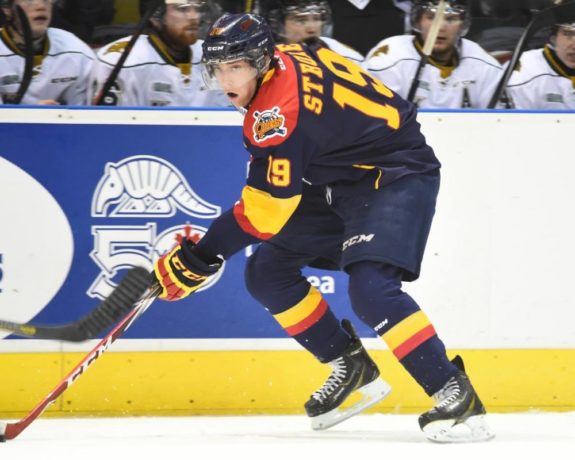For a team which scored the second-fewest goals last season, the first round pick, and third overall in Friday’s draft, for the Arizona Coyotes should be a no-brainer.
Here’s a team which generated the red light only 170 times during their 82 game schedule. That’s an average of 2.07 goals per game. Conversely, they allowed 272 goals per game, and only the Edmonton Oilers (283) and the Buffalo Sabres (274) surrendered more goals.
While goalie Mike Smith may have redeemed himself from a horrific season and led Team Canada to the recent World Championships, the Coyotes can not rely on the aging goalie as a barometer toward success.
This team need to focus on scoring.
Then again, general manager Don Maloney told several media outlets the Coyotes may be willing to trade their pick at number three. The rationale behind the move, Maloney believes, is players drafted 1 through 11 or 12 could all be impact players. If the Coyotes trade down from number three, Maloney holds his team can still pick a player worthy of a significant contribution.
Aside from number three, the Coyotes have seven additional picks in the 2015 draft, including the Blackhawks number pick at 30. That was part of the deal which sent Antoine Vermette to the reigning Stanley Cup champions.
Regarding a central philosophy of the draft, it seems to be a similar approach each year and in each sport. Some draft philosophers contend teams should select “the best player” available, and others argue to draft for need.

The draft approach for the NBA and NFL is different. Players are selected for immediate impact, and first round selections are expected to step right into the lineup to make an immediate contribution.
the need for offense
In the case of the Coyotes, their approach should address an immediate need, and that is lack of scoring.
While prospects Max Domi, Christian Dvorak, Branden Perlini and Anthony Duclair are expected to raise attention in training camp this fall, the Coyotes would be well served by going after offense with their third pick.
That would be Dylan Strome of the Erie Otters, and the high-scoring center should be directly on the Arizona radar screen.
Emerging from the shadow of Connor McDavid, Strome, at 6-3, 180 pounds, led the OHL in scoring with 129 points and third in the league with 45 goals. He iced the scoring title on the final day of the season with a six point effort (four goals, two assists).
“He has that competitive edge and grittiness,” NHL Director of Central Scouting Dan Marr told NHL.com. “He wants to succeed, wants the puck, wants to score and wants to win. He’s a skilled, driven player, a strong skater with the agility and reach that scouts love.”
Despite a second-line center to McDavid, Strome provided a surge of offensive lightning that the Coyotes desperately need. Going forward, bulk of the Arizona offense will come from younger players, and the traditional timeline of development could be compromised.
“(Strome) is ready to rise to the occasion,” Erie coach Kris Knoblauch told NHL.com. “He knew it would be more difficult. I didn’t want him to get too discouraged because there was the possibility of him drawing more attention, the top defensemen, the shutdown line, and his scoring going down. But his 5-on-5 play, his scoring went up. His power-play production went down a little bit because without Connor being there that affected him a little bit. For his overall game, we saw him step up.”
Now, the Coyotes need players, someone, anyone, who can generate a measure of offense, and remain a catalyst between demise and achievement.
Some contend the Coyotes could settle on forwards Mitch Marner or Ivan Provorov, or perhaps defenseman Noah Hanifin.
For their current need, Strome makes the most sense
To be NHL-ready, Strome will have to bulk up, and demonstrate as coach Dave Tippett likes to say, an ability “play with men.”
In the end, the Coyotes should be patient with Strome, throw him on a third line and leave him there. Sure, the NHL game may be a challenge initially, but the Coyotes should display patience and tolerance, and watch Strome develop as an important offensive force.
By the end of training camp, and in time for the Coyotes home opener with the Penguins on October 10, the duel of Sidney Crosby against Domi, Duclair, Strome and Perlini could be quite interesting.
Follow Mark Brown on Twitter, @jounalist193